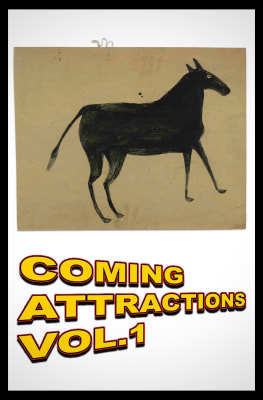Ricco/Maresca is pleased to introduce Coming Attractions, a series of exhibitions that will take place periodically in our Gallery Two space. The term "coming attractions" is particular to an era in American cinema (roughly between 1940 and 1980) when going to the movies was a major social activity. These previews were typically shown before the main feature at a movie screening and served to advertise upcoming films. The concept played a key role in the cinema experience, building anticipation and excitement among the audience. The style of these trailers has evolved over time, but in the mid-20th century, they often had a very direct and exuberant flair, with voiceovers that were emphatic and persuasive, using phrases like: "Don’t miss," "Coming soon," or "In this theater."
Coming Attractions, in the context of Ricco/Maresca, aims to capture the thrill of discovery that has historically been part of the gallery’s spirit. It will always present dissimilar works selected for their quality and freshness of expression. Vol. 1 presents a powerful “abstract blocks” variation quilt from Tennessee backed with feed sacks (ca. 1930-40), as well as a “hired man” sized quilt made with pieced fabrics and thread ties, a masterpiece of textile art (ca. 1920-30)—both quilts likely African American. Also included is a sophisticated mule drawing by Bill Traylor (1853 -1949), a contemplative scribe (likely a self-portrait) by Martín Ramírez (1895–1963), and a unique voting booth curtain (ca. 1920-30) made with canvas painted with stripes in the colors of the American flag, and stenciled: “MILLER AND DAVIS CO. MINNEAPOLIS, MINN. DISTRIBUTORS IN MINNESOTA FOR DOUGLAS COLLAPSIBLE VOTING BOOTH. MADE IN CRETE, NEBR.” Coming Attractions Vol. 1 also presents a selection of boldly lined, color-blocked portraits of women created by an obscure self-taught artist named Nelson Patrick Viola (1910 – 2008). Viola, who worked for a construction company in New York City’s Grand Central Terminal and served in World War II, left behind 200+ vibrant portraits of women inspired by newspaper photographs from the 1960s. The exhibition concludes with two anonymous SX-70 polaroid self-portraits, created in the 1970s, of a crossdresser enamored with their legs—130 of which were found in an abandoned self-storage unit in Massachusetts.
-
-
-
Concurrently on view in Gallery One:
Hester Simpson: My Grandfather's Trees
Visit the online viewing room here.







